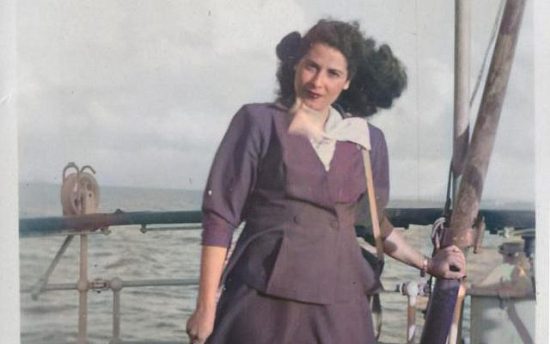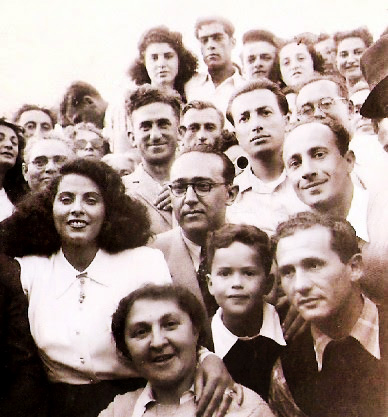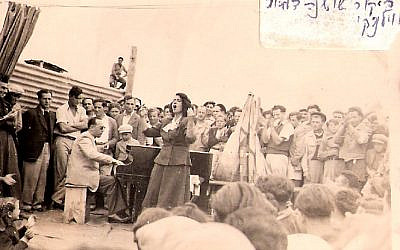אין מוצרים בסל הקניות.
THE BLOGS - Tania Shalom Michaelian
Yemenite Diva Sings to Jewish Refugees in Yiddish
פורסם: 13.3.2023

Remembering Shoshana Damari’s legendary visit to clandestine immigration (ma’apilim) detention camps in Cyprus on the eve of independence
Passover 1948. Although Eretz Yisrael was just a heartbeat away from independence, there were thousands of Jews still imprisoned in camps. The British authorities were determined to capture ships packed with clandestine immigrants making their way from the hells of Europe and stop them from anchoring off the coast of Mandate Palestine. As soon as these boats were captured, the immigrants were sent off to detainee camps in Cyprus and to the Atlit Detention Camp just south of Haifa
Many of these detainees were Holocaust survivors who once more found themselves transported by train to camps, disinfected at the entrance and incarcerated behind barbed wire. Despite these conditions, the Jewish survivors continued to dream of their freedom and to finally reach their own land
Jewish groups from the diaspora, as well as the Land of Israel did their best to ease the suffering of their fellow Jews in the camps. Besides meeting their immediate needs with food, tools and money, it was also decided to send a delegation to lift the spirits of the detainees and give them a taste of culture from the Land of Israel
The 1948 delegation that set out in April was as symbolic of the ‘Ingathering of the Exiles’ if ever there was one. Among many other talented individuals such as the national poet, Nathan Alterman, the delegation also included the Polish-Israeli composer Moshe Vilensky and the beautiful young Yemenite-born Shoshana Damari

Onboard a ship to the Cyprus detention camps. Picture: Atlit Detention Camp database
Although just 25 years old, Damari’s distinctive husky voice had already earned her a following of fans in her homeland to which she had immigrated with her family in 1924
For weeks before the famous visit, the detainees learned the words of the songs by heart so that they could sing along during the performances. Excitement was at its peak as the time of the visit drew closer
For seven days, Damari, accompanied by Vilensky on the piano and accordion, sang to the souls of the people in the camp. Their performances took place multiple times a day, under the open skies, in the middle of dry fields, on improvised stages, in huts housing sick detainees, before people who had lost their entire families in concentration camps, and before children who didn’t know what it was like to be free
Damari and Vilensky’s recently released song, Kalaniyot (‘anemones’) came as a gift to their new audiences, who were left spellbound and enamored
Shoshana Damari and Moshe Vilensky in Cyprus. Photos: Ein Hashofet Archives
Former camp inmate, Shalom Eitan described their performance as “one of the most emotional things I’ve ever witnessed.”
“The entire camp gathered on the football field, where in the middle an impromptu stage was erected,” he recalled. “On the stage stood a beautiful, dark-skinned woman, very tanned with a head of impressive black hair. But more beautiful than the way she looked was her voice! Those songs! She managed to electrify us all with her clear, impressive voice throughout the evening.”
To give the Jews of the camp a true taste of home, Damari had been determined to learn a song in a language with which they could identify best. It was thus her performance singing Rozhinkes Mit Mandlen (Raisins and Almonds), a traditional Yiddish lullaby-turned classic folk song, that truly hypnotized the crowd
Not only was her audience always in tears after the rendition of the song, but many times it was Damari herself who would choke up with emotion and could barely complete the verses
After one of her performances, a child shyly approached Damari and handed her a bunch of dried weeds. “Don’t be angry with me,” said the girl. “We don’t have flowers in the camp. When I come to Eretz Yisrael one day, I’ll give you real flowers on behalf of all the children in Cyprus.”
Shoshana Damari performing in Cyprus. Picture: Ein Hashofet Archives
Wrote Morris Laub, director for the Cyprus camps in a letter: “Shoshana Damari’s performance did such a lot of good for the detainees and uplifted their spirits with her magic. We must bring her to all the camps and communities across Europe.”
The visit by the cultural delegation was declared an unprecedented success, although all agreed that Damari was the star. Encapsulating the very spirit of the Jews of Eretz Yisrael, she managed to inspire hope and optimism in the detainees, who would finally get to walk the path of freedom into their new state just a few months later
The Atlit Detention Camp, under the auspices of the Society for the Preservation of Israel Heritage Sites (SPIHS) and its partners such as JNF-USA, tells the heart wrenching and heroic tales of the clandestine immigrants (ma’apilim) as they made their way to Mandate Palestine by land, sea and air. The camp’s information center contains over 130,000 names of immigrants who passed through the gates of the detention camps, as well as hundreds of personal interviews and written and video testimonials. SPIHS has made it its mission to keep adding to this database as long as there are stories to tell
Follow the SPIHS page on Facebook to learn more about the preservation of Israel’s heritage sites
Some of these articles were originally published on the Times of Israel blogs
חדשות ועדכונים אחרונים
עוגיות
אתר זה משתמש בעוגיות כדי לשפר את הפונקציונליות של האתר, לספק לך חוויית גלישה טובה יותר ולאפשר לשותפים שלנו לפרסם לך.
מידע המפרט על השימוש בעוגיות באתר זה וכיצד ניתן לדחות אותם, ניתן לצפות במדיניות העוגיות שלנו.
על ידי שימוש באתר זה או לחיצה על "אני מסכים", אתה מסכים לשימוש בעוגיות.







